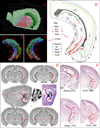Are the dorsal and ventral hippocampus functionally distinct structures?
- PMID: 20152109
- PMCID: PMC2822727
- DOI: 10.1016/j.neuron.2009.11.031
Are the dorsal and ventral hippocampus functionally distinct structures?
Abstract
One literature treats the hippocampus as a purely cognitive structure involved in memory; another treats it as a regulator of emotion whose dysfunction leads to psychopathology. We review behavioral, anatomical, and gene expression studies that together support a functional segmentation into three hippocampal compartments: dorsal, intermediate, and ventral. The dorsal hippocampus, which corresponds to the posterior hippocampus in primates, performs primarily cognitive functions. The ventral (anterior in primates) relates to stress, emotion, and affect. Strikingly, gene expression in the dorsal hippocampus correlates with cortical regions involved in information processing, while genes expressed in the ventral hippocampus correlate with regions involved in emotion and stress (amygdala and hypothalamus).
Figures




References
-
- Amaral DG, Dolorfo C, Alvarez-Royo P. Organization of CA1 projections to the subiculum: a PHA-L analysis in the rat. Hippocampus. 1991;1:415–435. - PubMed
-
- Anagnostaras SG, Gale GD, Fanselow MS. The hippocampus and Pavlovian fear conditioning: reply to Bast et al. Hippocampus. 2002;12:561–565. - PubMed
-
- Bannerman DM, Yee BK, Good MA, Heupel MJ, Iversen SD, Rawlins JN. Double dissociation of function within the hippocampus: a comparison of dorsal, ventral, and complete hippocampal cytotoxic lesions. Behav Neurosci. 1999;113:1170–1188. - PubMed
-
- Barrientos RM, O'Reilly RC, Rudy JW. Memory for context is impaired by injecting anisomycin into dorsal hippocampus following context exploration. Behav Brain Res. 2002;134:299–306. - PubMed
-
- Bast T. Toward an integrative perspective on hippocampal function: from the rapid encoding of experience to adaptive behavior. Rev Neurosci. 2007;18:253–281. - PubMed
Publication types
MeSH terms
Grants and funding
LinkOut - more resources
Full Text Sources
Other Literature Sources
Medical

